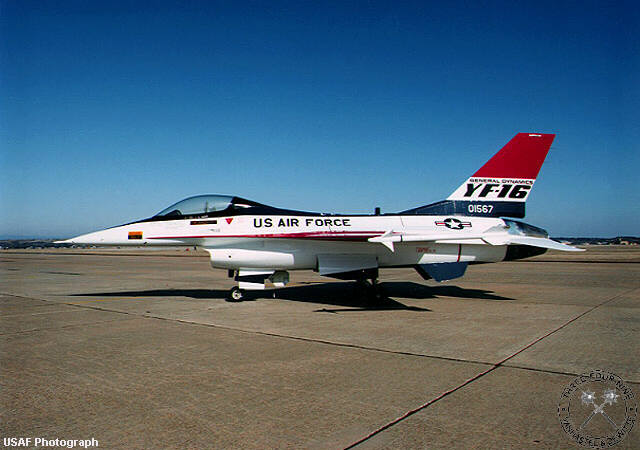Fighter Jet News
F-16 Fighting Falcon News
YF-16 turns 30
February 2, 2004 (by
Lieven Dewitte) -
When test pilot Phil Oestricher gently pulled back on the control stick of an experimental YF-16 jet and took off from Edwards Air Force Base 30 years ago, he was launching a remarkable era in aviation and Fort Worth history.
Today marks the 30th anniversary of the "official" first flight of the YF-16 (#72-1567), the prototype for the single-engine jet fighter that is arguably the finest combat airplane ever built.
The idea for the F-16 germinated in 1965. A few low-ranking Air Force officers and Pentagon officials, alarmed at the rising cost and poor performance of existing fighter jets, covertly began working to design an inexpensive, high-performance aircraft that could be built in large numbers. The effort was not blessed by senior officers, who would fight to kill the program.
The YF-16 was an experimental plane, one the Air Force didn't want to buy and General Dynamics wasn't interested in building. Even Phil Oestrichers said in a interviews that he never looked at the airplane as anything but a technology demonstrator. At the time, there were no production plans.
Harry Hillaker (84) was a co-conspirator from the beginning, meeting secretly with Col. John Boyd and a few other advocates. Phil Oestricher (72), an aerospace engineer and Marine fighter pilot, joined the program in 1971.
The Feb. 2, 1974, flight wasn't even the first one.
John G. Williams, a structural flight test engineer on the YF-16, recalls: "During the first high-speed taxi test, a violent lateral oscillation had set in as a direct result of pilot-commanded oscillations (several maximum left/right commands) as the airplane reached rotation speed (~120 kt). Remember, this was the first airplane to have a fixed stick, and there was no opportunity for Phil to gain any feel for the airplane, until that high-speed taxi test. As the nose of the aircraft rose, the tailplane inadvertently scraped on the runway. The left wingtip missile and the right tail static probe also lightly contacted the runway. Phil chose to take off because the bird had begun to veer off to the left side of the runway, and he was faced with plowing through the desert or flying. Thankfully he chose to fly and possibly saved the entire program. After take off, Phil regained control and stayed up for six minutes, and landed uneventfully. Prior to the next flight, the stick sensitivity was reduced by 50% with gear down. Later, after complaints of not enough sensitivity, it was returned to the original."
It wasn't long before the YF-16 team knew that they had accomplished their mission of designing a fighter plane that could outclimb, outturn and outmaneuver anything built before.
General Dynamics and Northrop Corp. had each been given $37 million to design and build two prototype planes, the latter the YF-17. The Pentagon held a fly-off to see which was best. According to Oestricher, it was not even a contest...
See our forum topic: Happy birthday F-16!
The idea for the F-16 germinated in 1965. A few low-ranking Air Force officers and Pentagon officials, alarmed at the rising cost and poor performance of existing fighter jets, covertly began working to design an inexpensive, high-performance aircraft that could be built in large numbers. The effort was not blessed by senior officers, who would fight to kill the program.
The YF-16 was an experimental plane, one the Air Force didn't want to buy and General Dynamics wasn't interested in building. Even Phil Oestrichers said in a interviews that he never looked at the airplane as anything but a technology demonstrator. At the time, there were no production plans.
Harry Hillaker (84) was a co-conspirator from the beginning, meeting secretly with Col. John Boyd and a few other advocates. Phil Oestricher (72), an aerospace engineer and Marine fighter pilot, joined the program in 1971.
The Feb. 2, 1974, flight wasn't even the first one.
John G. Williams, a structural flight test engineer on the YF-16, recalls: "During the first high-speed taxi test, a violent lateral oscillation had set in as a direct result of pilot-commanded oscillations (several maximum left/right commands) as the airplane reached rotation speed (~120 kt). Remember, this was the first airplane to have a fixed stick, and there was no opportunity for Phil to gain any feel for the airplane, until that high-speed taxi test. As the nose of the aircraft rose, the tailplane inadvertently scraped on the runway. The left wingtip missile and the right tail static probe also lightly contacted the runway. Phil chose to take off because the bird had begun to veer off to the left side of the runway, and he was faced with plowing through the desert or flying. Thankfully he chose to fly and possibly saved the entire program. After take off, Phil regained control and stayed up for six minutes, and landed uneventfully. Prior to the next flight, the stick sensitivity was reduced by 50% with gear down. Later, after complaints of not enough sensitivity, it was returned to the original."
It wasn't long before the YF-16 team knew that they had accomplished their mission of designing a fighter plane that could outclimb, outturn and outmaneuver anything built before.
General Dynamics and Northrop Corp. had each been given $37 million to design and build two prototype planes, the latter the YF-17. The Pentagon held a fly-off to see which was best. According to Oestricher, it was not even a contest...
See our forum topic: Happy birthday F-16!
Related articles:
Tags
Tags


